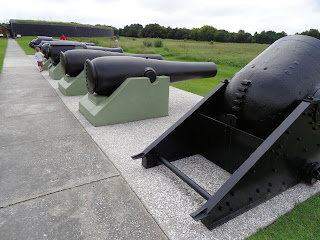While
most come to Sullivan’s Island to enjoy the beaches or eat at famous Poe’s
Tavern, there’s another side to this beach resort town that is easily discovered
with a visit to the west end of the island, and Fort Moultrie. Part of Fort Sumter National Monument, Sullivan’s Island is actually closer to Fort Sumter
than both of the ferry ports, Patriot’s Point and Liberty Square; they depart
from the downtown Charleston area while the fort is between James and Sullivan’s
Islands, both forts standing guard at the mouth of the Charleston harbor to the
Atlantic.
The
first palmetto-log fort on Sullivan's Island wasn’t finished when it was
attacked by the British in 1776. The June 28th battle ended in British
retreat, although they returned in 1780, capturing Charleston and keeping it
until the end of the war. The fort was named after its commander in that
initial battle, Colonel William Moultrie.
After
the Revolution, Fort Moultrie was all but abandoned, and by 1791 there was
little left of it. When war broke out between England and France in 1793 Congress
authorized the first system of coastal fortifications and a 2nd Fort
Moultrie was completed in 1798. Destroyed by a hurricane in 1804, a third (brick)
Fort Moultrie was built.
In my
opinion the most interesting thing about the series of forts ringing Charleston
Harbor (Moultrie, Sumter, Johnson, and Pinckney), is that they were meant to be
a collaborative effort at keeping the enemy at bay, but actually ended up being on center stage pitted against one another in the Union/Confederate conflict as the site of the first shots
of the Civil War. SC seceded from the Union, and the Federal garrison abandoned
Fort Moultrie for Fort Sumter, deeming the former too weak and hard to defend. (More
on that in my post Celebrate your wedding anniversary at Fort Sumter!)
In
April 1863, the Union began a 20-month bombardment of Sumter and Moultrie. The defenses held, although both forts were basically a pile of rubble at the
point when the Confederate army evacuated the city in February 1865. Moultrie
was rebuilt and modernized in the 1870s and again in 1885, but eventually
larger weapons were placed further east on the island and the fort became just
a small piece of the Fort Moultrie Military Reservation.
A
visit to today's restored Fort starts at the Fort Moultrie Visitor Center, where visitors
can view educational exhibits and get a copy of the Junior Ranger program
booklet. After watching the orientation film we headed across the street,
entering the fort through the Sally Port entrance.
A full
exploration of the fort can take a few hours as it is certainly larger than it
seems, partially underground, and a comprehensive visit will also include a
trip around the forts walls. Additionally visitors can take the “Cannon Walk”
with artillery pieces that date from the Civil War to Battery Jasper, part of
the coastal defense system.
We
ducked over to the ocean, getting our feet wet on a strip of sand that lay
between concrete rubble (to protect against erosion) and the water. That tiny
taste of the ocean was enough to plant a seed of impatience in us all on this
hot day, leading us to abandon the fort in search of swimming and sandcastles… but not before being sworn in as Junior Park Rangers, that is.
Open 9am
to 5pm daily (except on certain holidays), there is an admission fee to visit
the Fort: please see the National Park Service website for more information.









We've been to Fort Moultrie also... Interesting area.... So glad you are 'educating' those kids as to our history....Great place to visit.
ReplyDeleteHugs,
Betsy
Hi Betsy, thanks for your comment! The boys are pretty much educating themselves on these trips; their enthusiasm is contagious, and Roberts and I are learning just as much as they are!
Delete